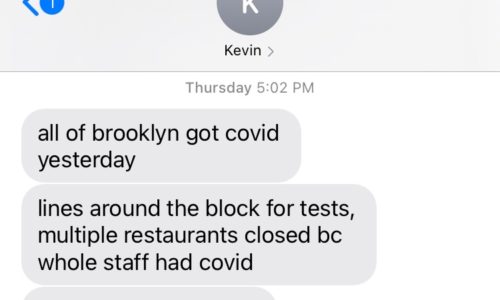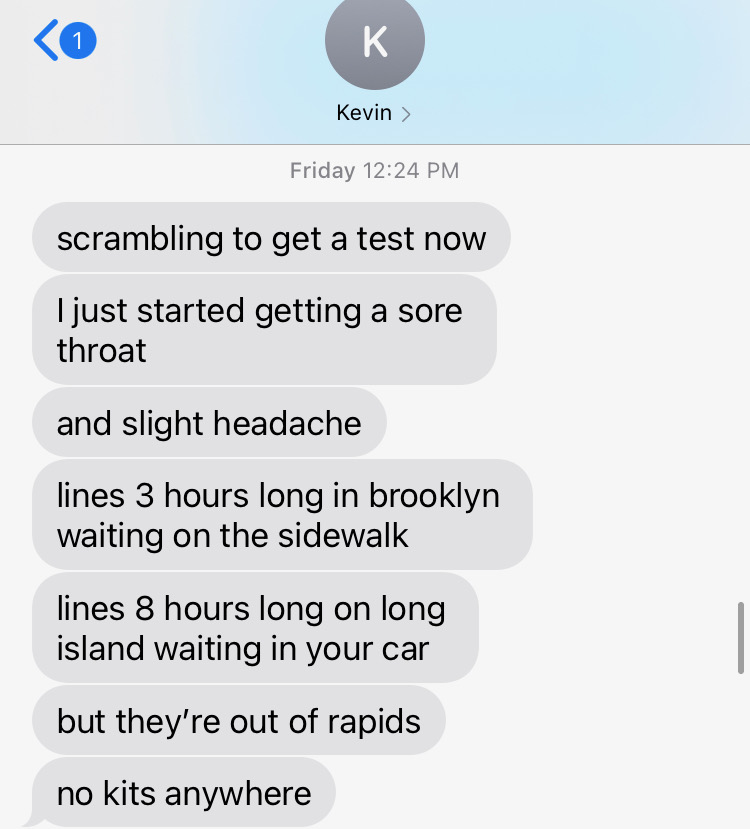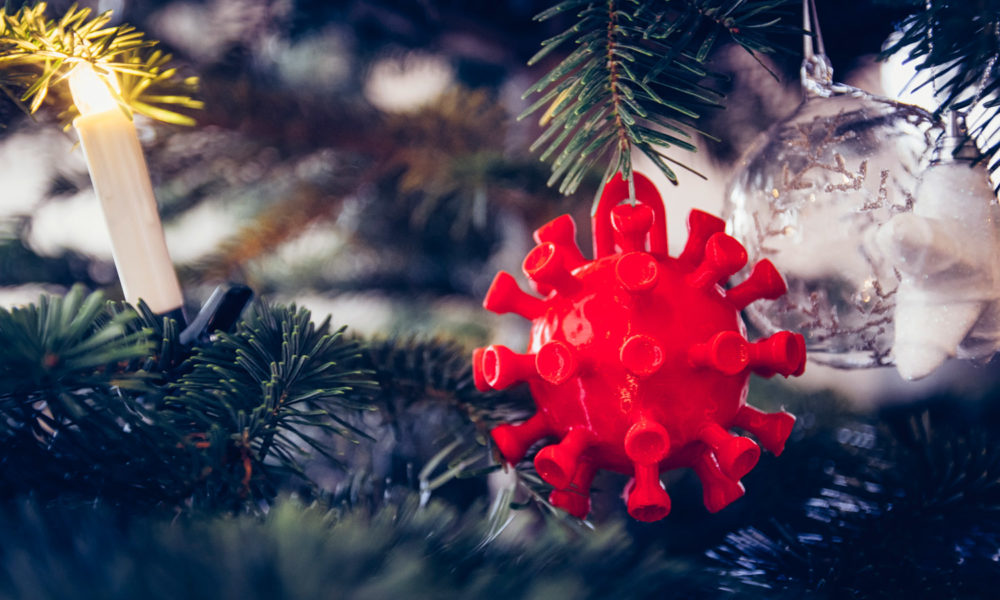The Omicron variant’s rapid spread seems to be sweeping the globe faster than Santa’s reindeer on Christmas Eve. As a result, this year will be the first time that I won’t make it home for Christmas. Over the weekend, members of my immediate and extended family on Long Island tested positive for COVID-19 and won’t be out of isolation in time to celebrate together.

This is not a unique experience—new cases are up more than 20 percent from two weeks ago across the country. But the thing about living through a pandemic for almost two years is that even when you know all your plans could change in a moment, you still…make them. Now, just days before Christmas, we have no decorations, no plans, no supplies for holiday activities, and no gifts for each other; those are all already at my parent’s house. (We won’t even see a “white Christmas,” as Chicago’s record-breaking “no snow” streak reminds us that we are living through a climate crisis and a pandemic concurrently).
When it’s just you and your partner in an apartment that was *not* prepared to provide all your holiday cheer, it’s easy to feel like you’re on your own—especially since Congress has gone home for the holidays without passing critical support for families and working people, like my brother, who works for a restaurant that was forced to close on Monday due to COVID-19 infections.
There is a lot we still don’t know for sure about the new Omicron variant, such as how it will impact our healthcare system, how deadly it will be, and how it will change the strategies of governments and public health officials working to stop the spread. But there is a lot we do know. I might not be able to save your Christmas, but I wanted to share some of the science and resources I’ve been following from public health experts and colleagues as Omicron looms over our holiday season.
The Omicron variant is highly contagious
Based on the science and reporting to date, it seems clear that the mutations of the Omicron variant make it far more contagious than previous versions of the novel coronavirus, including the Delta variant. In addition, early research indicates that the Omicron variant is very good at evading the immunity people have acquired from vaccinations or prior infections.
The Omicron variant also spreads fast—exponentially fast. After being detected by South African scientists in late November, it took less than a month for Omicron to become the dominant COVID-19 variant in the US. According to the CDC, documented cases of the Omicron variant have jumped sixfold in just the last week and models indicate that the variant now accounts for almost 75 percent of new COVID-19 cases. Anecdotally, this aligns with my own personal experience of the large number of family and friends who have gotten infected or exposed in just the last few days.

Masks will still protect you, but cloth masks offer less protection than better quality masks
Personally, my family and I have ditched the cloth masks that were bought or handmade in the earlier days of the pandemic in favor of more protection, especially since public health experts are warning that single-layer cloth masks may be insufficient against the omicron variant.
Now whenever I travel or spend time indoors in public—even in spaces that require proof of vaccination—I use masks that are certified to filter a high percentage of airborne particles (think 94% or higher). These include:
- KF94 masks: Made in South Korea, these masks are regulated to filter at least 94 percent of airborne particles, though some have filtered even higher amounts in testing. These are what I use, since good N95s are out of my price range and KF94 masks have been less problematic in terms of counterfeit masks.
- N95 masks: These are certified by the National Institute for Occupational Safety & Health (NIOSH) to filter at least 95 percent of airborne particles as small as 0.3 microns. When properly fitted, they provide some of the best protection possible against airborne transmission. They can be expensive, though, and public health experts warn that it’s hard to ensure a proper fit, which is key for the mask to function as designed. In addition, there are fake ones out there to avoid.
- KN95: Essentially the Chinese version of the N95. Please also be careful to avoid counterfeit versions.
Lack of testing capacity is making this worse
Given how quickly Omicron is spreading and how easily the mild symptoms of fully vaccinated people can be confused for a cold or the flu, it’s clear that testing is an essential tool for containing its spread. As much of a bummer it is to miss Christmas, my family is grateful that positive tests caught the virus before we got together. Yet the latest surge is straining testing capacity across the country as demand rises. According to the New York Times, the number of COVID-19 tests taken jumped over 50 percent from two weeks ago.

There are testing centers all around the country offering free tests, but lines are growing. At-home antigen tests remain expensive and are often out of stock, and at-home PCR tests are even more costly. That’s why I am closely watching the Biden administration’s efforts to ensure that COVID-19 tests are easy to access and afford.
Vaccinations—and boosters—are still critical
My brother’s COVID-19 case is one of many breakthrough cases of the Omicron variant—he is fully vaccinated and boosted. At the same time, breakthrough cases do not invalidate the importance of getting vaccinated. While I twiddle my thumbs over Christmas, I won’t also have to worry that my brother’s case will become dangerous, because the science shows that vaccines and boosters clearly reduce the risk of infections becoming severe. Similarly, the data show vaccines help limit transmission by making it harder for the virus to infect you and produce enough virus to transmit to others.
The CDC strongly recommends vaccinations for everyone age 5 and over. The CDC also recommends booster shots for those who have already been vaccinated. Unfortunately, unlike my brother, less than two-thirds of the US population ages five and older are fully vaccinated, and less than one-third of the US population ages 18 and older has received a booster shot, according to CDC data.
My mom, who was exposed by my brother, and my aunt, who was exposed by her children, had received booster shots. This makes us all feel safer that this Christmas, while a bit lonely, won’t be tragic. Yes, people who have been “boosted” are still testing positive—but that makes boosters even more critical, to help your body fight the virus and minimize the risk of a severe infection. In addition, booster shots can still prevent infection altogether. I am especially encouraged that early data from laboratory testing on Pfizer and Moderna’s booster shots show a big jump in neutralizing antibodies able to fight Omicron. Moderna’s booster showed a 34-fold increase and Pfizer-BioNTech’s booster showed a 25-fold increase, compared to two doses alone.
This is good news for the US, where Moderna and Pfizer vaccines are widely available. But most of the world’s vaccines fall short on neutralizing the omicron variant.
Thinking of the rest of the world: Global vaccine equity is key
Even as it seems that almost everyone I know has been exposed or infected, experiences like that of my family pale in comparison to the risks faced by the billions of people around the world. Indeed, less than half of the world is fully vaccinated, and early data indicate that vaccines used in other parts of the world may not be as effective against Omicron infection compared to mRNA vaccines such as Moderna and Pfizer. In addition, vaccines are distributed unevenly, with only 7.1 percent of people in low-income countries receiving just one dose so far. Without strong vaccination rates globally, it is harder to stop the spread of variants like Omicron.
The Biden administration has pledged to donate over 1 billion vaccine doses by 2023, enough to vaccinate about 6 percent of the global population. But so far, the US has successfully donated fewer than 350 million doses. Experts say 11 billion doses are needed to vaccinate 70 percent of the world’s population and estimate that we will have reached that level of vaccine production by the end of the year. Unfortunately, rich countries are still stockpiling more vaccines than are needed for booster campaigns.
Instead of reacting to new developments with racist travel bans, the United States should focus on increasing vaccinations globally.
Science helps keep us safe
My husband and I may mostly be stuck home with our cats, but we are grateful for the science that allowed my family to test for infection before they spread further, and for the scientific tools, like masks and vaccines, that keep our families safe.
While boring and sad, the symptoms of our Covid Christmas are mild. For those who can still gather for the holidays and beyond, boosters, testing, and good masks are tools you can use to keep the party-crashing Omicron at bay.

